Introduction
Power analysis is the name given to the process for determining the sample size for a research study. The technical definition of power is the probability of detecting a "true" effect when it exists. Many students think that there is a simple formula for determining sample size for every research situation. However, the reality is that there are many research situations that are so complex that they almost defy rational power analysis. In most cases, power analysis involves making simplifying assumptions that make the problem tractable and running the analyses numerous times with different variations to cover all of the contingencies.
In this unit we will try to illustrate the power analysis process using a simple four group design.
Description of the experiment
We wish to conduct a study in the area of mathematics education involving different teaching methods to improve standardized math scores in local classrooms. The study will include four different teaching methods and use fourth grade students who are randomly sampled from a large urban school district and are then random assigned to the four different teaching methods.
The four different teaching methods to be examined are 1) the traditional teaching method where the classroom teacher explains the concepts and assigns homework problems from the textbook; 2) the intensive practice method, in which students fill out additional work sheets both before and after school; 3) the computer assisted method, in which students learn math concepts and skills from using various computer based math learning programs; and 4) the peer assistance learning method, which pairs each fourth grader with a fifth grader who helps them learn the concepts followed by the student teaching the same material to another student in their group.
Students will stay in their math learning groups for an entire academic year. At the end of the spring semester all students will take the Multiple Math Proficiency Inventory (MMPI). This standardized test has a mean for fourth graders of 550 with a standard deviation of 80.
The experiment is designed so that each of the four groups will have the same sample size. One of the important questions we need to answer in designing the study is how many students will be needed in each group?
The power analysis
In order to answer this question, we will need to make some assumptions and some educated guesses about the data. First, we will assume that the four groups will have the same standard deviation and that it will be equal to the national value of 80. Further, after looking at prior research, we expect that the traditional teaching group (Group 1) will have the lowest mean score and that the peer assistance group (Group 4) will have the highest mean score on the MMPI. In fact, we expect that Group 1 will have a mean of 550 and that Group 4 will have mean that is greater by 1.2 standard deviations, i.e., the mean will equal at least 646. For the sake of simplicity, we will assume that the means of the other two groups will be equal to the grand mean.
To perform the power analysis, we will make use of Sample Power’s ‘Oneway analysis of variance’ procedure, under the ‘ANOVA’ tab in the Procedures catalog.
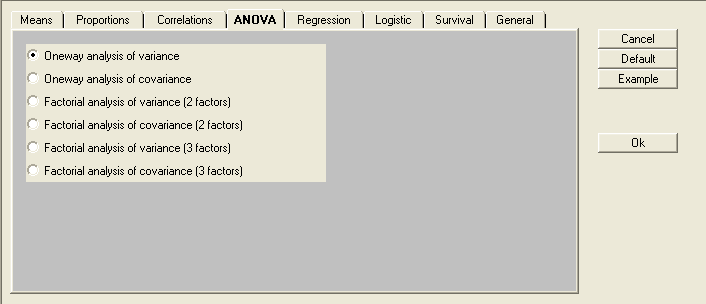
To proceed, we require 1) the number of levels (or groups), 2) the effect size (called delta), and 3) the alpha level. As stated above, there are four groups. We will set alpha = 0.05 and the standard deviation (SD within cell) to 80 and we will then compute the effect size. There are a number of ways to accomplish this, all of them accessible by clicking on either the number of cases input cell or the effect size input cell. A window is opened, requesting a variety of inputs.
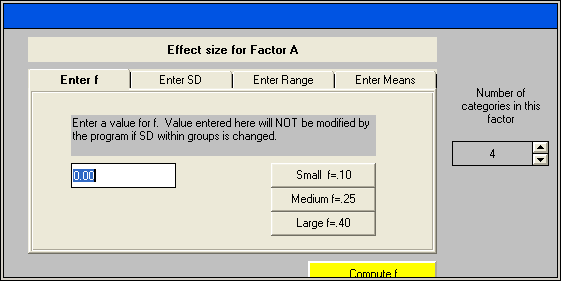
First, we indicate how many groups we have in the box below "Number of categories in this factor"–we set this to 4. From here, clicking the ‘Enter Means’ tab, we can input the expected means of the four groups. We already have the mean = 550 for the lowest group and the mean = 646 for the highest group. We will first set the means for the two middle groups to be the grand mean. Based on this setup and the assumption that the common standard deviation is equal to 80, we can do some simply calculation to see that the grand mean will be 598. Alternatively, we can use the ‘Enter Range’ tab, inputting the high and low means and selecting a centered distribution (given our assumption that the means of the two middle groups will be equal to the grand mean). Regardless of the method used, clicking ‘Compute f’ followed by ‘Register f’ will calculate the effect size and transfer it to the main window.
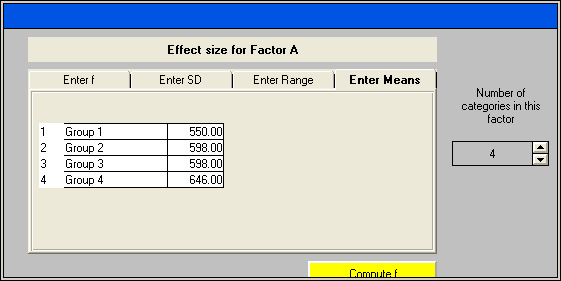
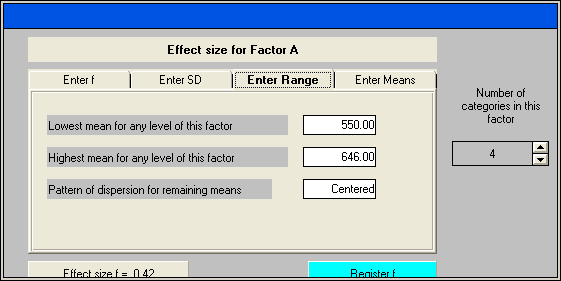
Let’s now set the power to be .8 and calculate the corresponding sample size by clicking the ‘Find N for any power’ button.

This means we need total of 17*4 = 68 subjects for the power of .8.
If we want to see how sample size affects power, we can close the ‘Find N for any power’ window, adjust the number in ‘N of cases per cell’ (in the lower right-hand corner), and observe the change in achieved power.
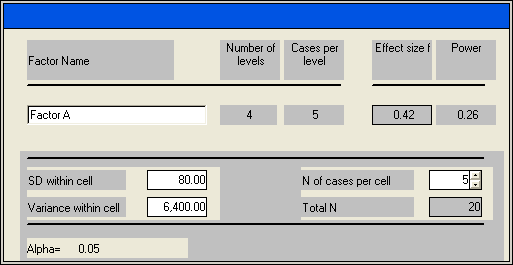
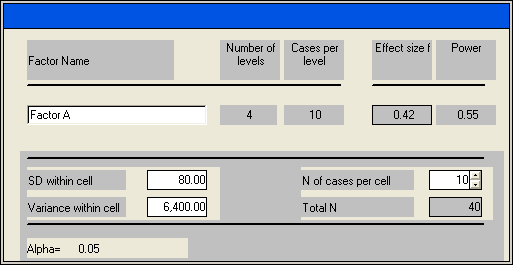
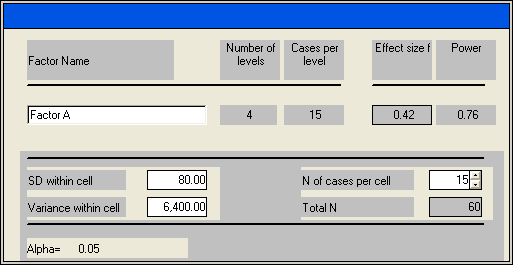
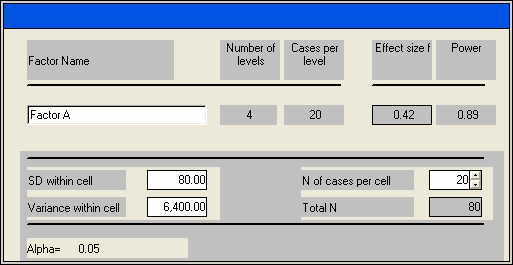
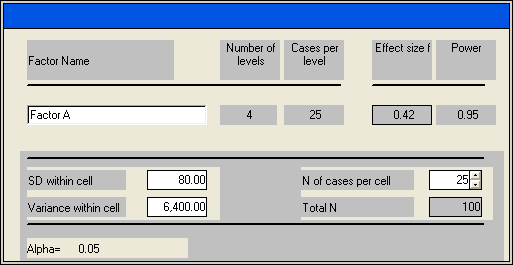
So we see that when we have 25 subjects in each group, we will have power of .95.
In the setup above, we worked under the assumption that the two middle groups will have means equal to the grand mean. Now in general, the means for the two middle groups can be anything in between. If you have a good idea on what these means should be, you might want to make use of this piece of information in your power analysis. For example, let’s say the means for the two middle groups should be 575 and 635. We will set the power to .8. Note that for this calculation, the ‘Enter Means’ tab in the Effect Size window must be used.
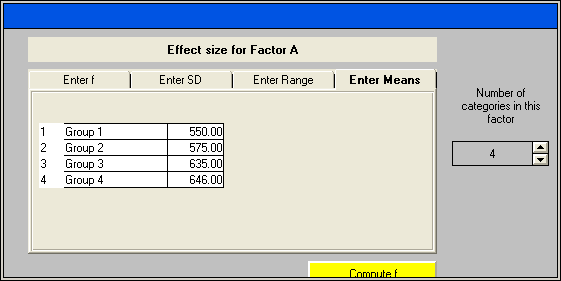

So we see that for power of .8 we need fewer subjects than before when the two middle groups have the mean as the grand mean. This should be expected since the power calculated here corresponds to the overall F test for the ANOVA and when the means are further away from the grand mean, it is easier to detect the group effect.
Effect size
The difference of the means between the lowest group and the highest group over the common standard deviation is a measure of effect size (note that this measure of effect size (delta) is in fact different from the one used and displayed in Sample Power (f)). In the calculation above, we have used 550 and 646 with common standard deviation of 80. This gives effect size of (646-550)/80 = 1.2. This is considered to be a large effect size. Let’s say now we have a medium effect size of .75. What does this translate into in terms of groups means? Well, we can always use 550 for the lowest group. The mean for the highest group will be .75*80 + 550 = 610. Let’s assume the means of the two middle groups are the grand mean, say g. Then we have (550 + g + g + 610) / 4 = g. This gives us g = (550 + 610)/2 = 580. Let’s now redo our sample size calculation with this set of means.
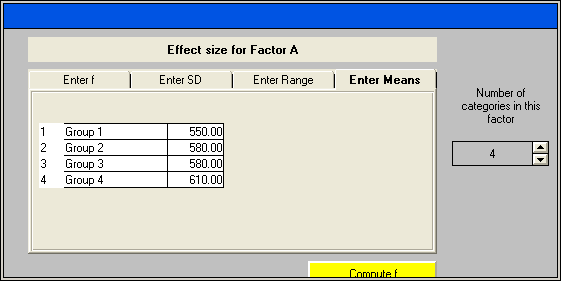

So we see that at size of 40 for each group, we have power of .8.
What about a small effect size, say, .25? We can do the same calculation as we did previously. The mean for each of the groups will be 550, 560, 560 and 570.
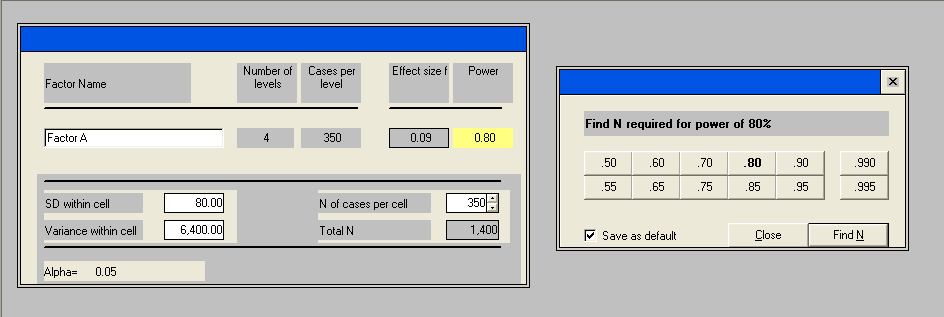
When the effect size is small, the required sample size increases drastically.
Discussion
The sample size calculation is based a number of assumptions. One of these is the normality assumption for each group. We also assume that the groups have the same common variance. As our power analysis calculation is rooted in these assumptions, it is important to remain aware of them.
We have also assumed that we have some knowledge of the magnitude of effect we are going to detect which is described in terms of group means. As we saw in the last example with the small effect size, this can have an enormous impact on the required sample size. When we are unsure about the groups means, we should use more conservative estimates. For example, we might not have a good idea on the two means for the two middle groups, then setting them to be the grand mean is more conservative than setting them to be something arbitrary.
Here are the sample sizes per group that we have come up with in our power analysis: 17 (best case scenario), 40 (medium effect size), and 350 (almost the worst case scenario). Even though we expect a large effect, we will shoot for a sample size of between 40 and 50. This will help ensure that we have enough power in case some of the assumptions mentioned above are not met or in case we have some incomplete cases (i.e., missing data).
For more information on power analysis, please visit our Introduction to Power Analysis seminar.
